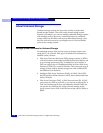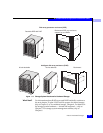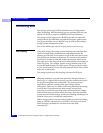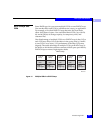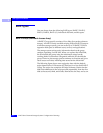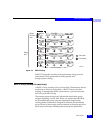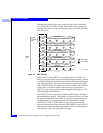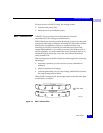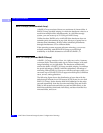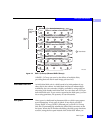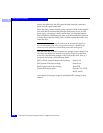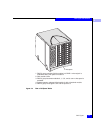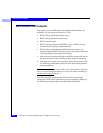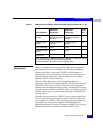
2
2-6
EMC Fibre Channel Storage-System Configuration Planning
RAID Types and Tradeoffs
The following figure shows user and parity data with a data block
size of 2 Kbytes in a RAID 3 Group. Notice that the byte addresses
proceed from the first disk to the second, third, and fourth, then the
first, and so on.
Figure 2-3 RAID 3 Group
RAID 3 differs from RAID 5 in several important ways. First, in a
RAID 3 Group the hardware processes disk requests serially; whereas
in a RAID 5 Group the hardware can interleave disk requests. Second,
with a RAID 3 Group, the parity information is stored on one disk;
with a RAID 5 Group, it is stored on all disks. Finally, with a RAID 3
Group, the I/O occurs in small units (one sector) to each disk. A
RAID 3 Group works well for single-task applications that use I/Os
of blocks larger than 64 Kbytes.
Each RAID 3 Group requires some dedicated SP memory (6 Mbytes
recommended per group). This memory is allocated when you create
the group and becomes unavailable for storage-system caching. For
top performance, we suggest that you do not use RAID 3 Groups
with RAID 5, RAID 1/0, or RAID 0 Groups, since SP processing
power and memory are best devoted to the RAID 3 Groups. RAID 1
mirrored pairs and individual units require less SP processing power,
and therefore work well with RAID 3 Groups.
EMC1816
Second disk
Third disk
Fourth disk
Fifth disk
Stripe
element
size
Stripe
si
ze
…
…
…
…
…
First disk
User data
Parity data
2048-2559 4096-4607 6144-6655 8192-8603
0-511
512-1023 2560-3071 4608-5119 6656-7167 8604-9115
5120-56311024-1535 3072-3583 7168-7679 9116-9627
3584-40951536-2047 5632-6143 7680-81919628-10139
Parity Parity Parity Parity Parity
Data block
Bytes



